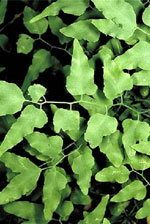Threats to Birds - Old World Climbing Fern (Lygodium micropyllum)
Overview
An exotic from Asia, Africa, and Australia, this climbing fern is advancing across the Everglades by an estimated 18 acres/day. It was first found in the wild in Florida in the 1950's. Since its discovery, it has invaded 150,000 acres across Florida from East to West. It climbs over other plants and smothers trees such as cypresses, bays, and willows. It also kills sawgrass marshes, which has the potential to devastate the Everglades and the $8.4 billion restoration project. Old World climbing fern is already taking over the Arthur R. Marshall Loxahatchee NWR, a northern remnant of the Everglades ecosystem. Found in cypress wetlands, Everglades tree islands, floodplain, hammocks, roadside ditches and disturbed corridors.
Description
Fern with dark brown, wiry rhizomes and climbing, twining fronds to 90 feet long; main rachis is wiry, stemlike. Leafy branches off rachis once compound; leaflets usually unlobed, stalked and without hairs; fertile leaflets fringed with tiny lobes of enrolled leaf tissue covering the sporangea along the leaf margin.
Birds Affected Wood Stork; Snail Kite; herons, egrets, rails and bitterns; wading birds.
Control
Burning and pulling the fern causes its spores to parachute into the air, spreading the pest even more widely. Herbicides are somewhat successful; spot spraying is the preferred method in the fragile Everglades. The Florida Deptartment of Environmental Protection has Lygodium hit teams whereby if a new outbreak is discovered, they will quickly treat the area. Bio-control through insects is under research. |
